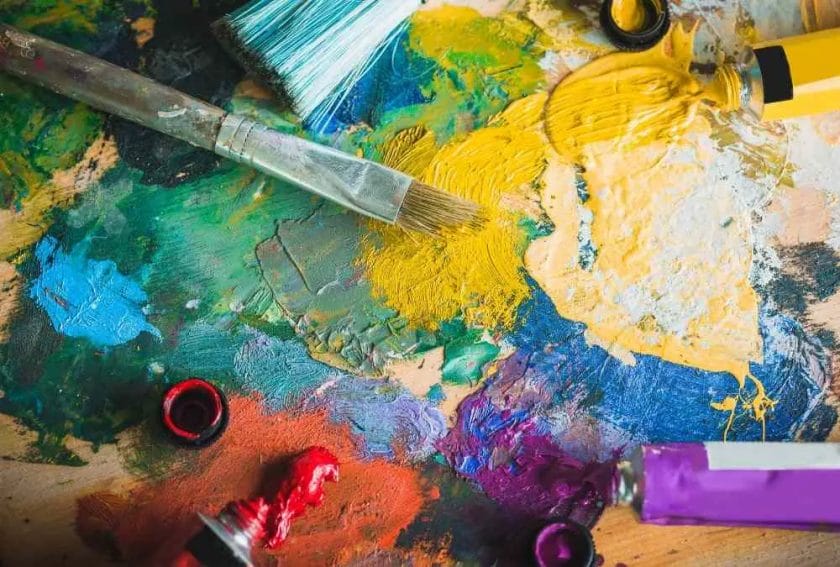Yes, you can use wax over acrylic paint, but there are a few things to keep in mind.
First, the wax will protect the paint from damage and wear, but it can also yellow or discolor the paint over time. Second, if you’re using a dark wax, it can be difficult to remove and may require some elbow grease.
You can choose from a wide variety of tinting waxes to use. The most commonly used type of wax on acrylic paint is cold wax and it’s available in different brands.

Cold wax can be heated with turpentine and doesn’t require melting before use. Layering cold wax over your acrylic paint holds a lot of benefits and here are some of them:
- Applying wax over your acrylic paint seals the painted surface and gives it a flat finish.
- The wax protects the surface of your acrylic painting from scratches and dirt for more longevity.
- It also acts as a final finish on your finished artwork, giving it an easy-to-clean surface.
- Finally, the wax acts as a waterproofing material. Upon contact with water, the wax keeps the acrylic paint from washing off.
Despite the many benefits of layering your acrylic paint with wax, I’ll recommend that if you aren’t comfortable with the idea, don’t try it.
Also, if it’s your first time layering cold wax over your paint, try the wax on a test area first. Don’t forget to put on hand gloves and ensure adequate ventilation when applying wax over acrylic paint.
How to Use Wax Over Acrylic Paint?
As you know that you can use wax over acrylic paint, let’s move on to how to use wax over acrylic paint. Follow these simple steps to layer your acrylic paint with wax:
Materials Needed
- Your completed and dry acrylic paint
- A container of cold wax (your preferred brand)
- Clear acrylic gesso
- A Spatula
A wide flat paintbrush (or a clean paper towel)
Lay Your Acrylic Paint Flat
Lay your dry acrylic painting flat on a leveled surface, raising it slightly with props.
Apply Clear Acrylic Gesso
Use a flat paintbrush to evenly apply the clear acrylic gesso on the surface of the acrylic paint. The essence of the clear acrylic gesso is to add texture to your acrylic painting. The texture, in turn, enables the cold wax to adhere properly to the surface of the acrylic paint.
While a professional acrylic painter may decide to skip this step, a beginner acrylic painter must go through this process to achieve the desired result. Allow the acrylic gesso to dry before moving to the next step.
Apply the Cold Wax
Open the wax container and take some wax out using a spatula. Paste the scooped wax on your dry painting. Don’t forget to close the lid of the wax container and keep it closed so it doesn’t dry out.
Spread the Wax Through
Using a wide flat paintbrush, spread the wax evenly all over the surface of the acrylic paint in a circular motion.
You can also use a clean paper towel in place of the paintbrush for a better result. Unlike a paper towel, a paintbrush tends to leave visible brush strokes on the surface of the painting.
Try as much as possible to spread the wax gently to avoid scratching off your acrylic paints during the process.
Allow the Wax to Dry
After applying the wax all over the acrylic paint, leave it to dry for about 30 to 40 minutes. This is important as it allows the wax to sink into the acrylic paint and harden up.
You can use a hair dryer to speed up the drying process, but I’ll recommend that you wait for it to dry on its own.
Bring Out the Sheen
Once your waxed acrylic paint is completely dry, gently rub the surface with a clean paper towel to polish it. This brings sheen to the surface of the paint.
For a better result, apply a little effort when polishing the surface of the paint.
If you want a more matte finish, skip this step altogether.
You can also add a second layer of cold wax if you desire. Just follow the steps above to do so.
Things to Avoid When Using Wax Over Acrylic Paint
There are certain things you should avoid when using wax over acrylic paint. These include:
Don’t Use Hot Wax
Hot wax can be dangerous as it can easily cause burns. It can also melt your acrylic paint, which you obviously don’t want.
So, avoid using hot wax on your acrylic paints altogether.
Don’t Use Mineral Spirits or Turpentine
Mineral spirits and turpentine are solvents that can dissolve your acrylic paint. So, don’t use them to thin out your wax or remove it
Don’t Use a lot of Wax
If you use too much wax, it will become difficult to buff and polish the surface of your painting. It can also make your painting look cloudy. So, avoid using too much wax.
A little goes a long way!
Now that you know how to use wax over acrylic paint, go ahead and give it a try. Experiment with different techniques and see what works best for you. And don’t forget to share your results with us in the comments below!
